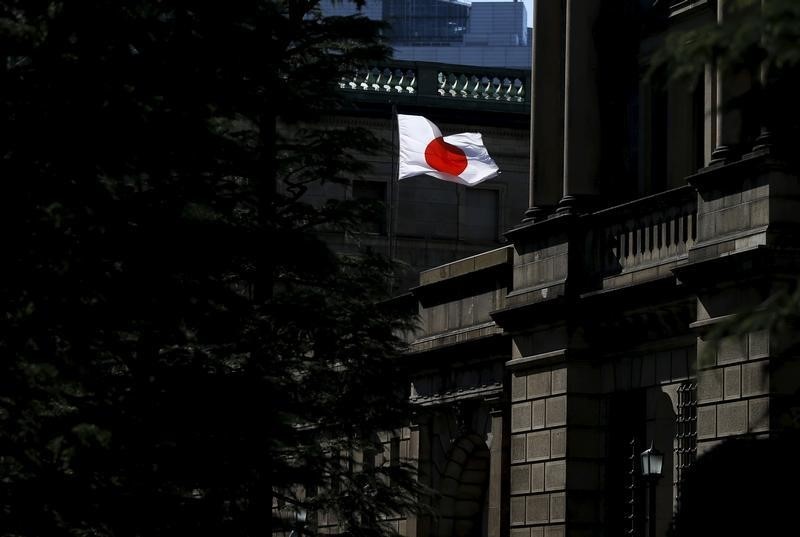Investing.com-- The Bank of Japan (BOJ) is set to conclude a two-day policy meeting on Tuesday, with markets engaging in rampant speculation over what could be the BOJ’s first rate hike in 17 years, as well as the reaction from the Nikkei 225 and the USDJPY to such a move.
Signs of higher Japanese wages, sticky inflation and some resilience in the economy drummed up expectations that the BOJ could end its ultra-dovish negative interest rate (NIRP) and yield curve control (YCC) policies by as soon as its March meeting.
Media reports also suggested that BOJ members were in advanced talks over raising interest rates from negative territory.
This speculation pulled Japanese stock markets, particularly the Nikkei 225, down from record highs, and also helped the yen’s USDJPY pair fall as far as 146 to the dollar over the past week.
But the Nikkei rebounded sharply on Monday, while USDJPY rose back to around 149.
The BOJ kicked off a two-day meeting on Monday, and is expected to deliver its decision after the conclusion of the meeting around 12:30 JST (23:30 ET) on Tuesday.
Bank of Japan rate decision on tap, is a 20 bps hike due in March?
Signs of higher wages and sticky inflation factored into expectations for a “virtuous cycle” outlined by the BOJ. These are the two main considerations signaled by the central bank to begin ending its YCC and NIRP policies.
As such, markets began pricing in the possibility of a 20 basis point (bps) hike by the BOJ, raising its short-term interest rate to 0.1% from negative 0.1%. Such a hike will be the BOJ’s first such move since 2007, when it had raised interest rates just before the Great Financial Crisis.
But analysts were still split over whether such a move will come in March or April.
BOFA, who is among the proponents for a March hike, said it saw three key reasons for such a scenario-
“We think the case for March is strengthened by 1) recent improvement in capex data, which paint a better picture for domestic demand; 2) aggressive union wage demands, which raise the likelihood that FY24 Shunto wage hikes will beat last year's by a significant margin; and 3) recent media reports suggesting discussion over the post-YCC framework are in very advanced stages,” BOFA analysts said in a recent note.
But they also noted that a March move was not a “done deal,” stating that the BOJ would have much more useful data by April to begin tightening policy then.
Citi analysts were in the slight majority of market watchers who said a rate hike was coming only in April, but that the BOJ was likely to signal an end to its ultra-dovish policies on Tuesday.
“We see April as more likely than March… BOJ officials have indicated a gradual approach to communicating termination. Also, April has the advantage of greater data availability for decision making,” Citi analysts said in a note.
Citi expects Japanese interest rates to reach 0.25% by January 2025.
USDJPY outlook after the BOJ
The Japanese yen’s USDJPY pair is widely expected to fall sharply in the event of a BOJ rate hike, given that a widening gap between U.S. and Japanese interest rates was a key weight on the yen over the past two years.
Any signals on an end to the BOJ’s ultra-dovish policies are also expected to support the yen, pulling down the USDJPY.
Speculation over a BOJ policy shift had triggered heavy volatility in USDJPY over the past week. The pair had fallen as far as 146 before recovering to around 149 on Monday.
But while the USDJPY is expected to fall on any hawkish signals from the BOJ, any major moves in the yen will be largely held back by anticipation of a Federal Reserve meeting later in the week.
“The yen is struggling to trade on the strong side, possibly suffering from a “buy the rumour, sell the fact” effect. At the same time, we have stressed multiple times how a sustainable rally in the yen relied more on a decline in US rates than a BOJ rate hike,” analysts at ING wrote in a note.
Nikkei outlook after the BOJ
Japanese stocks, particularly the Nikkei 225, slid from record highs over the past week as speculation grew over a BOJ pivot. An end to the YCC and NIRP policies also marks an end to nearly a decade of easy monetary policy enjoyed by Japanese stocks- a factor that was also a key driver of stellar gains in the Nikkie over the past two years.
But the Nikkei shot up on Monday as markets bet that even if the BOJ ends its ultra-dovish policies, it is likely to hold off on drastically tightening policy for the near-term.
“Even if the BoJ does exit YCC and NIRP it will likely remain conservative regarding an end to zero interest rates and emphasize that the monetary environment will remain accommodative for some time. While volatility on the Japanese equity market is likely to increase around the time of BoJ meetings, we do not expect a major correction,” Citi analysts wrote in a note.
Higher wages also present more strength for the Japanese economy- a trend that is likely to bolster corporate earnings and keep local equities strong.
